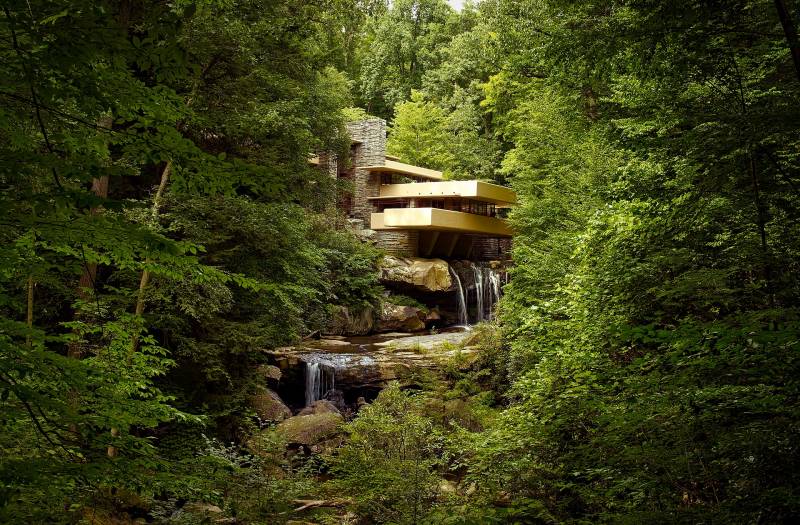 Our Modern High Back Chairs mirror the High Back Chairs that Frank Lloyd Wright designed back in the early 1900's.
Our Modern High Back Chairs mirror the High Back Chairs that Frank Lloyd Wright designed back in the early 1900's.Frank Lloyd Wright (1867-1959) is one of the most well-known architects of all time. He is often referred to as the “father of organic architecture” for his work to pioneer and define the concept. Throughout his career, Wright designed more than 1,000 structures, many of which remain historical icons.
Although he was best known for his work in designing buildings, he also made significant contributions to the field of furniture design. Inspired by the mission & craftsman movement of the early 1900’s, many of Wright's designs included the vertical rectangular cuts seen so often in the furniture of that period. However, Wright went beyond the established designs of the American Craftsman era, infusing his own signature style into chairs, tables, and more.
During the later stages of his career, Wright’s furniture designs would evolve from distinctly craftsman into what would help to define the style now known as mid-century modern.
Organic Architecture: Design in Harmony with Nature
"So here I stand before you preaching organic architecture: declaring organic architecture to be the modern ideal and the teaching so much needed if we are to see the whole of life.” - Frank Lloyd Wright, An Organic Architecture (1939)
Organic architecture is a method of design that aims to harmonize man-made structures with the natural world. Creations that utilized the philosophy of organic architecture greatly influenced the trajectory of the design world. To Frank Lloyd Wright, embracing organic architecture meant:
- Levying the natural landscape. For example, if a large rock was present, then the build may incorporate it into the design or work around it instead of removing it—a heavy contrast to how most construction projects are done today.
- Blurring the lines between a building’s interior and nature. Often done by incorporating earthy color schemes, natural materials, motifs found in nature, and large windows.
- Everything is well-thought out and purposeful. Nothing should be added or subtracted without considering what it does to the design’s form and function as a whole. This philosophy is said to create and maintain a synergy that mirrors how nature functions.
Renowned Designs by Frank Lloyd Wright
Some of Wright's most renowned work includes buildings like Fallingwater, Unity Temple, the Guggenheim Museum, and Taliesin. His most recognizable furniture designs include the High Back Dining Chair, Barrel Chair, Prairie Style Chair, and Cyprus Round Back Chair.
Fallingwater
 Fallingwater, one of Wright's most prominent works, melds seamlessly into the surrounding nature. Image by David Mark from Pixabay.
Fallingwater, one of Wright's most prominent works, melds seamlessly into the surrounding nature. Image by David Mark from Pixabay.Organic architecture can be seen in many of Frank Lloyd Wright’s projects but is highly prominent in the iconic Fallingwater. This house built in rural Pennsylvania was designed by Wright 1935 for the Kaufmann family. It wasn’t until 1966, 7 years after Wright’s death, that Fallingwater was declared a National Historic Landmark.
From March to December, you can buy tickets to tour Fallingwater. Or, if you’re looking for something a little extra, they also offer tour packages that include brunch or a forest to table dinner.
Taliesin
 Taliesin (1911) has been touted as a prime example of organic architecture. The horizontal lines and gentle slopes mimic the natural surroundings. (Image Source)
Taliesin (1911) has been touted as a prime example of organic architecture. The horizontal lines and gentle slopes mimic the natural surroundings. (Image Source)Taliesin, often called Frank Lloyd Wright's "autobiography in wood and stone," is an 800 acre property in Wisconsin on which Wright designed and built several buildings. Taliesin was home to Wright's house, studio, school, and farm.
Read more about Taliesin.
The Legacy of Frank LLoyd Wright
 Our showroom, Stonehurst, is a perfect example of building in harmony with nature. Through our stewardship of this 100-acre property, we hope to be able to connect our customers with a working forest, like the ones our furniture comes from.
Our showroom, Stonehurst, is a perfect example of building in harmony with nature. Through our stewardship of this 100-acre property, we hope to be able to connect our customers with a working forest, like the ones our furniture comes from.The work of Frank Lloyd Wright has had a profound impact on the trajectory of architecture and interior design. His design philosophies, which he coined under the term "organic architecture," have influenced countless other architects and designers. Wright was one of the driving forces behind the shift towards greener and more sustainable buildings.
One prominent study, Architect David Pearson, would later distill Wright's vision of organic architecture into a set of guidelines that he deemed the "Gaia Charter." The Gaia Charter proposed by Pearson in the late 1900s lists a set of guiding principles for this movement. Pearson outlines a school of thought built around designing for harmony with the planet, peace for the spirit, and health for the body.
Wright's contributions go beyond his designs and extend into his vision and the impact that he's had on other designers. F. L. Wright is credited with steering the world towards more sustainable buildings and homes.

